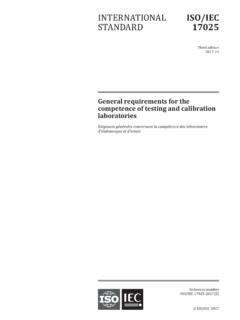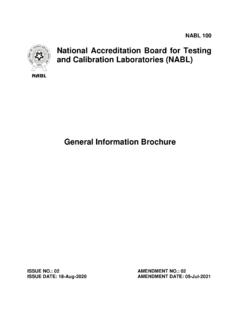Transcription of Laboratory Quality Standards - WHO
1 Laboratory Quality Standards and their Implementation WHO Library Cataloguing-in-Publication data Laboratory Quality Standards and their implementation. 1. Laboratory Techniques and Procedures manpower Standards . 2. Quality control. 3. Delivery of Health Care. 4. Laboratory Personnel. 5. Clinical Laboratory Information Systems. 6. Equipment and Supplies. 7. Guidelines. I. World Health Organization, Regional Office for South-East Asia. II. World Health Organization, Regional Office for the Western Pacific. ISBN 978 92 9022 397 9 (NLM classification: QY 25).
2 World Health Organization 2011. All rights reserved. Requests for publications, or for permission to reproduce or translate WHO publications . whether for sale or for noncommercial distribution can be obtained from Publishing and Sales, World Health Organization, Regional Office for South-East Asia, Indraprastha Estate, Mahatma Gandhi Marg, New Delhi 110 002, India (fax: +91 11 23370197; e-mail: ). The designations employed and the presentation of the material in this publication do not imply the expression of any opinion whatsoever on the part of the World Health Organization concerning the legal status of any country, territory, city or area or of its authorities, or concerning the delimitation of its frontiers or boundaries.
3 Dotted lines on maps represent approximate border lines for which there may not yet be full agreement. The mention of specific companies or of certain manufacturers' products does not imply that they are endorsed or recommended by the World Health Organization in preference to others of a similar nature that are not mentioned. Errors and omissions excepted, the names of proprietary products are distinguished by initial capital letters. All reasonable precautions have been taken by the World Health Organization to verify the information contained in this publication.
4 However, the published material is being distributed without warranty of any kind, either expressed or implied. The responsibility for the interpretation and use of the material lies with the reader. In no event shall the World Health Organization be liable for damages arising from its use. This publication does not necessarily represent the decisions or policies of the World Health Organization. Printed in India Contents Acknowledgements ..v Abbreviations .. vii Scope and objectives .. ix 1. 1. 2. Development and implementation of the Quality system.
5 5. 3. Developing Laboratory Quality Standards .. 7. Organization and management .. 7. Quality management system (QMS) .. 9. Human resources (personnel) .. 11. Accommodation and environmental 12. Laboratory safety .. 13. Laboratory 15. Procurement and supplies management .. 17. Information management .. 18. Managing Laboratory specimens .. 19. Customer service and resolution of complaints .. 24. Outbreak alert and Laboratory 24. 4. Implementing Laboratory Quality Standards .. 27. 5. Further reading .. 29. Annexes 1. Quality Manager .. 31. 2. Safety Officer.
6 33. 3. Suggested model safety rules for health laboratories .. 35. Laboratory Quality Standards and their Implementation iii Donated 37. Example of a standard operating procedure (SOP).. 39. Checklist for Laboratory Quality Standards .. 47. 59. iv Laboratory Quality Standards and their Implementation Acknowledgements The first draft of this document was developed by Mr John Elliot, Director, Pacific Paramedical Training Centre, Wellington, New Zealand. We gratefully acknowledge his contribution as well as inputs from several experts (Annex 7). in finalization of this document.
7 Laboratory Quality Standards and their Implementation v Abbreviations CPD continuing professional development CQI continuous Quality improvement EQAS external Quality assessment scheme FIFO first in first out HBV hepatitis B virus HIV human immunodeficiency virus IEQAS international EQAS. IHR International Health Regulations (2005). ISO International Standards Organization IQC internal Quality control MoH Ministry of Health NEQAS national EQAS. PCR polymerase chain reaction PEP post-exposure prophylaxis PPE personal protective equipment QA Quality assurance QC Quality control QM Quality manager QMS Quality management system REQAS regional EQAS.
8 Laboratory Quality Standards and their Implementation vii SI Systeme Internationale (of units). SOP standard operating procedure TAT turnaround time UPS uninterrupted power supply WHO World Health Organization viii Laboratory Quality Standards and their Implementation Preface Scope and objectives The objective of this document on Laboratory Quality Standards is for it to be used as a guideline for evaluation, development and implementation of Quality systems and Standards for health Laboratory services. The internationally accepted Standards of the International Standards Organization (ISO) 15189.
9 And ISO 17025 have stringent requirements and can usually be met only by laboratories either at the national level or by specialized reference laboratories. They are often very resource-intensive and many countries find it difficult to implement them. Since laboratories in developing Member States are at different levels with respect to Quality , the Standards outlined in this document, while based on the ISO Standards , have been simplified to encourage Member States to follow them. A flexible step-wise approach is encouraged so that these guidelines become a stepping-stone to achieving the ISO Standards .
10 Establishing and maintaining Laboratory Quality Standards are essential. This document presents a minimum set of Standards that can be readily adapted by countries and applied to laboratories at every level of the health-care system. Suggestions are also provided on ways to implement them. They are important for several reasons, including ensuring the Quality and traceability of patients' results; supporting clinical and public health decision-making;. procuring equipment; use of standard techniques and reagents; for sharing documentation; training programmes; Quality assurance; meeting requirements for reimbursement for national insurance schemes; and compliance with national or international accreditation and licensing systems.











